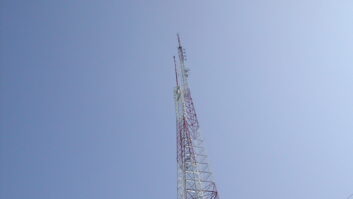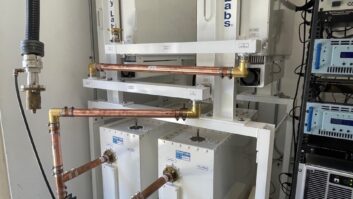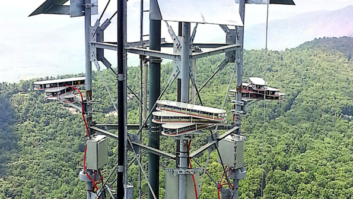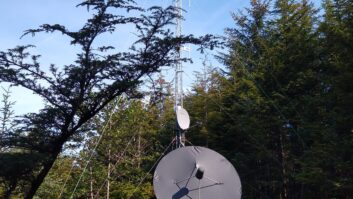New tower standards
Apr 1, 2002 12:00 PM, By John Battison, P.E., technical editor, RF
The onset of digital television has greatly boosted interest inbroadcast towers. Existing towers that once were regarded by owners asnecessary evils now receive favored treatment in their new guise asvaluable vertical real estate. Most existing towers today probably haveas many antennas and as much ancillary equipment hung on them as theycan carry without collapsing. So the push is on for new towerconstruction, not only for digital television antennas but for all thenew sources of communication inspired radiators that require stable skyhooks hundreds of feet in the air. This means that both AM and FMstations may be affected by the new tower standards when they are putinto force.
The pending Revision G tower changes allow for some grandfathering ofinstallations.

The broadcast tower industry has made fantastic strides since thebeginning of radio. There have, of course, been a few spectacular towercollapses, generally caused by high winds and or ice, and occasionallyby vandalism. I can’t recall any whose failure was officially blamed onover loading; although most of us have seen towers that we would hateto be near in a high wind. In much the same manner as most criticalengineering projects are safeguarded, broadcast tower construction hasalways conformed to specific engineering standards.
In the U.S., the joint TIA//EIA-222 standard oversees the design ofbroadcast and antenna supporting towers. Standards are not static andthey are reviewed every five years to ensure that they keep pace withindustry demands, safety requirements and new construction methods.Each successive revision carries a capital letter designator. Sometimesno changes are warranted and a revision may last for many years. Anearlier revision, Revision C, was kept in use for nearly twenty yearsbefore being replaced by a new version. The current Revision F willremain in use until Revision G has been completed and approved by thevarious industry committees.
The engineering group that establishes the TIA/EIA standards has atwo-part job. First they have to ensure that the approved design ruleswill satisfy the safety requirements of the new and often verysophisticated antenna systems that the new communications worldrequires. They also have to be familiar with the local and nationalbuilding codes so that their new revisions are acceptable to thesegroups.
Revision G will accomplish a number of new things. In the pastowners of tall towers have had difficulty in satisfying localauthorities, not only about usually unfounded concerns of non-ionizingradiation, but fears of falling towers (plus general dislike oftowers).
As presently proposed, the new standard will make severalsignificant changes. Among others the safety requirement regardingclimbing, working and the additional load of personnel working on atower will be covered. The minimum safety requirements will be based onthe use of qualified and experienced personnel.
In the field of safety the rather out-of-date design theories ofRevision F are about 20 years old. The new Revision will take intoaccount the latest steel design theory based on national buildingtrends.
Tower loading
At the present time any �add on� structures such as FM,STL, cell or similar communication antennas are not considered as partof the original tower in their design, As a result we can expect tofind structures smaller than the main FM antennas designed to the samestructural limits as the tower itself.. This should help in loweringwindage values and possibly in icing load conditions.
Wind loading on towers is the major consideration when planning anew structure. Ice loading is of course a serious factor in towerdesign, but it is generally a temporary rather than permanentconsideration. The effect and control of ice loading will of coursealso be addressed in Revision G.
Wind loading is calculated based on wind speed. The government haschanged the method of measuring and assessing the effect of wind ontowers. At present, wind loading is calculated based on �thefastest-mile wind speed� encountered once in 50 years for thetower site. This means that the wind speed is determined by averagingthe highest speed of one mile of wind driving the anemometer at theproposed site. Because the time required to obtain the top speed isvariable and depends on wind velocity, high wind speeds require shorterrecording time. This can result in incorrect or misleading wind loadingfigures.
Revision G is expected to base wind loading on the �threesecond gust wind speed.� This will also use the once-in-50-yearsmaximum value but it will be the maximum speed measured for a period ofthree seconds at the tower site. Basing tower design on the peak gustoccurring over three seconds is designed to take the maximuminstantaneous loading in account.
Put simply, the old formula allows for variations in the speedduring that time. Most of the country’s weather services use the newmethod of measurement of gusts in three second periods. The use ofthree second gusts provides a broader base for tower designers. A pointto remember is that the new and old wind speeds cannot be compareddirectly because the Revision G wind speed of 100 mph for a threesecond gust is not the same as a 100 mph fastest wind gustspeed. The latter value of 100 mph for three seconds would seem to havemore effect on a tower than a single short gust of 100mph.
The broadcast engineer’s b�te noire is the ice thatcomes without warning and drags a tower down. It is most likely thatice will now be included as a part of the tower’s mandatory load, andthe ice area map will be included. The currently used Revision F onlycalls for icing to be considered if the tower is in an �iceregion.� It is felt that this is rather too arbitrary, and thenew standard probably will nominate regions where icing has to beconsidered. Structural requirements will probably be based on ice dataplus height of the tower, site elevation and the degree ofexposure.
The question that many engineers will probably be asking is:�Will Revision G apply to my existing tower?� If no changesare to be made to the original load specification, and a professionalengineer has certified that it was satisfactory, there will probablynot a be any effect on an existing tower. But if new antennas, etc. areto be added to an existing tower that will change its loading beyondthe original specification, then Revision G will no doubt apply.
E-mail Battison at[email protected].
More info:
It willprobably be the end of 2002 before the numerous committees involved increating the new revision have completed their deliberations. In themeantime, Pirod has developed an interesting and useful bookletdescribing the efforts and effects of the anticipated Revision G. Itwas written by Myron C. Noble, PE., the president of Pirod, to letengineers know what will probably be changing in the towerspecification world. It is available free from Pirod at PO Box 128,Plymouth, IN 46563.













